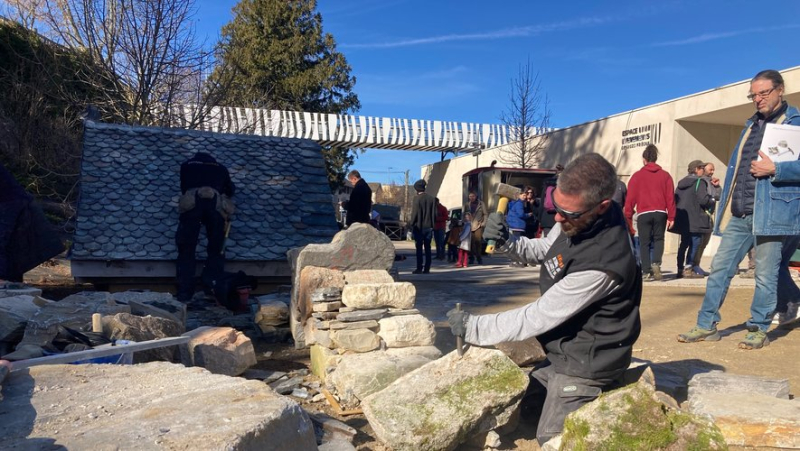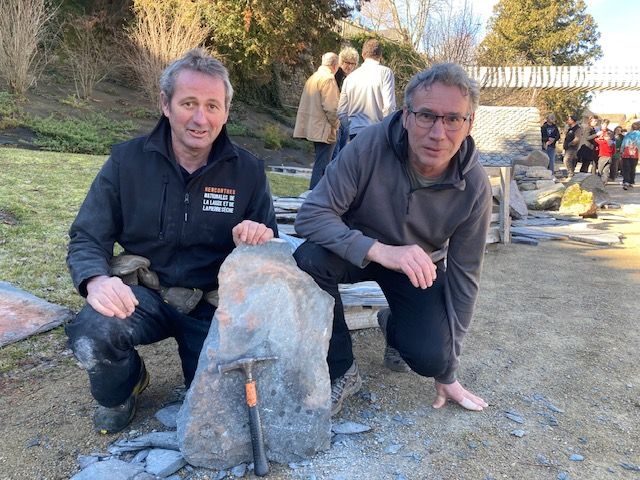National meetings: quarrymen, tailors, lauziers and roofers, artisanal trades anchored in stone

Laurent, bâtisseur en pierre sèche, fait une démonstration de son métier. MIDI LIBRE – M. P
Les deuxièmes rencontres nationales de la lauze et de la pierre sèche ont eu lieu à l'espace événements à Mende les 2 et 3 février 2024. Le public a pu découvrir des artisans animés par la passion de leur métier.
The national slate and dry stone meetings were open to the public on Saturday February 3, 2024, under the aegis of the Association of Dry Stone Builders (ABPS) and the Association of Dry Stone Builders (ABPS). Association of lauzier roofers (ACL). On the square in front of the Georges-Frêche space, a curious village of die-hard artisans was set up. Here, no mortar or trowels but hammers and chisels.
Laurent, dry stone builder
Laurent is a dry stone builder, based near Tournon-sur-Rhône in Ardèche. He hits and hits a block again. "Before, I was a farm worker but I wanted to do this job. I followed itinerant training. Since then, 90% of my turnover has been devoted to this activity, he says. Walls, vaults, stairs, calades, nothing stops it: "It is individuals, municipalities, winegrowers who call on me". He only sees advantages in stone construction: "It's a directly exploitable, draining material. A wall will last a long time and the raw material can be exploited again." Only enemy, the roots of trees, "but a well-maintained wall is practically immortal", he smiles. Before the eyes of the curious, the shape of the block emerges, which will match that of the neighbor: < em>"You must always anticipate the laying of the next stone. It's a big puzzle. For young people, there is a future. You just have to pay attention to your body." An allusion made to the heavy loads to be moved.
Joseph and Ludovic, lauzier roofers
The two roofers are laurel roofer trainers in the center of Chastel-Nouvel. In front of the public, Ludovic shapes a phonolite slate: "Each slate has a place on the roof, depending on its shape. And you have to respect the thicknesses, it's 3D." The work is meticulous: "We install 2 to 3 m2 per day. In tiles, it's ten times more. Except that the slate roof will last at least a century", comments Joseph.

Joseph and Ludovic, lauzier roofers. FREE NOON – M. P
Near them, a pile of reclaimed slates: "They are a hundred years old and we are going to put them back. A saying from ours says that whoever lays slate, for a hundred years lays it." The two professionals have some fears: the scarcity of careers and the lack of&# 39;apprentices to embrace the profession. "We are trying to unite", they reassure themselves. & ;nbsp;
David, quarryman in Lozère
The Lozerian operator is based in Saint-Julien-du-Tournel: "The quarry, which dates from at least the 12th century, is located between two granite massifs, between Margeride and Mont-Lozère. The extracted shale is conditioned by these outcrops." The professional is authorized to extract 3,000 tonnes per year (one truck per week) from his one-hectare quarry, for 30 years. The sampling takes place by plates : "We visually choose the final destinations, roof, masonry or ground". David is not worried about the future: "We are little thumbs in the industry, with specific work. We adopt the market even if the economic profitability is not necessarily there." The career has been in the family for several generations: < em>"My children are attracted to this profession", he smiles.
A conference on the memory of stone
Jean Guillaume Bordes, archaeologist and lecturer at the University of Bordeaux, specializing in lithic technology, Michel Brenet, prehistorian and archaeologist at Inrap, Georges Matichard from the Monik Lézart company presented a dramatized conference on the stone, with a very fun popularization for the public. “How did we go from flint to cell phones in 3.3 million years ?” was a preamble question. Experts have traveled to archaeological sites around the world, using images, to show that, since the dawn of time, stone has been a bearer of memory: "We reach the first civilizations thanks to the stones that we find on the excavation sites. We only have this as testimony. And the light too, which shows the organization of the size of a flint for example. It’s a link between us and them, the gestures were the same. Stone, indestructible witness to the work of the first men.
I subscribe to read more




